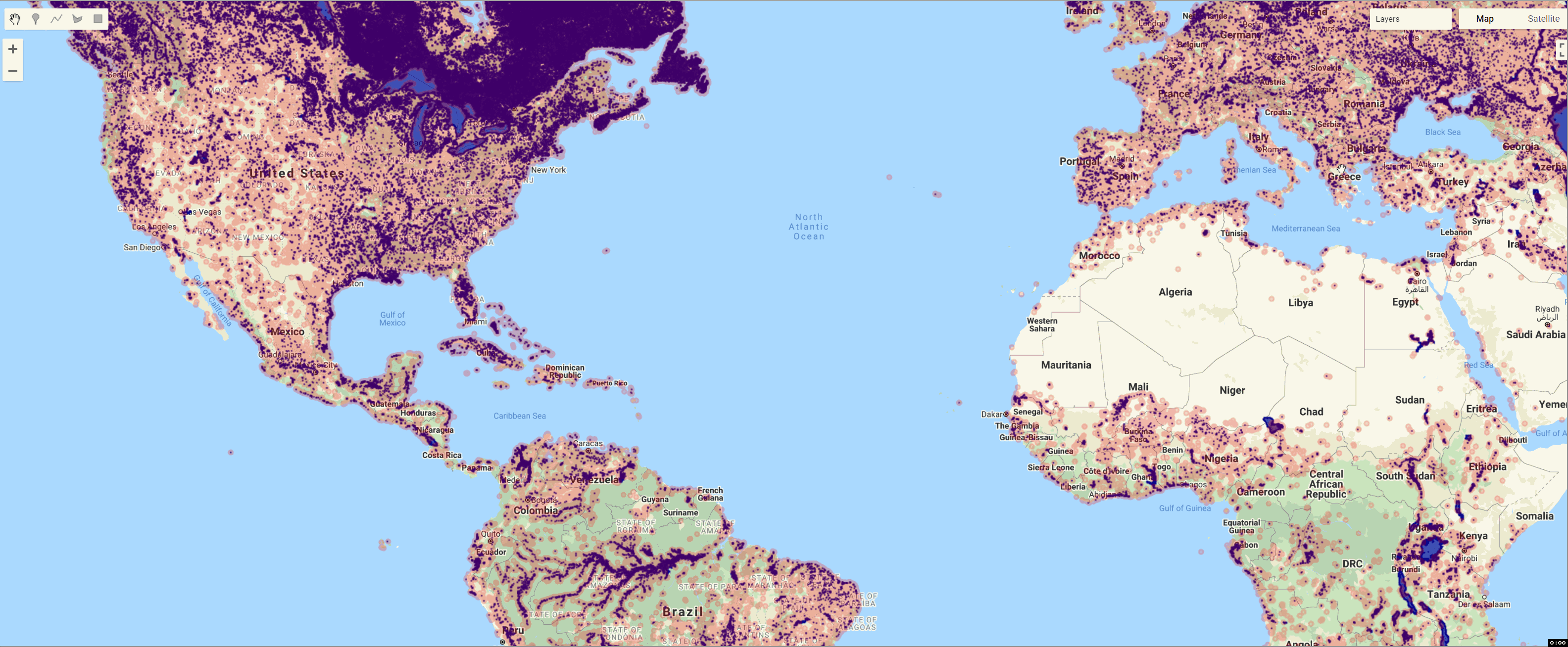Google Earth Engine(GEE)——全球湖泊数据集HydroLAKES v1.0(大于10公顷的湖泊)
Google Earth Engine(GEE)——全球湖泊数据集HydroLAKES v1.0(大于10公顷的湖泊)

此星光明
发布于 2024-02-02 14:28:17
发布于 2024-02-02 14:28:17
HydroLAKES v1.0 湖泊是生物地球化学和生态过程的关键组成部分,因此有关其分布、体积和停留时间的知识对于理解其特性和在地球系统中的相互作用至关重要。然而,全球信息匮乏,不同空间尺度和地区的信息也不一致。在这里,我们开发了一个地理统计模型,根据周围的地形信息,估计表面积至少为10公顷的全球湖泊的体积。
HydroLAKES数据库被设计成一个数字地图库,包括所有表面积至少为10公顷的湖泊,总表面积为2.67×106平方公里(占全球陆地面积的1.8%),总海岸线长度为7.2×106公里(约为世界海洋海岸线的4倍),总体积为181.9×103平方公里(占全球非冰冻陆地水总量的0.8%)。HydroLAKES的目标是在全球范围内尽可能的全面和一致,包含了淡水湖和盐湖,包括里海,以及人造水库和受管制的湖泊。
HydroLAKES可公开下载,网址是http://www.hydrosheds.org,可免费用于科学、教育和其他用途。
用于创建HydroLAKES的数据集
Original dataset | Region | Original format and resolution | Reference | Number of lakes |
|---|---|---|---|---|
Canadian hydrographic dataset (CanVec) | Canada (entire country) | Vector; 1:50,000 | Natural Resources Canada (2013) | 863550 |
Shuttle Radar Topographic Mission (SRTM) Water Body Data (SWBD) | 56° South to 60° North | Raster; 1 arc-second (~30 m at the equator); vectorized and smoothed | Slater et al. (2006) | 282571 |
MODerate resolution Imaging Spectro-radiometer (MODIS) MOD44W water mask | Russia above 60° North | Raster; 250 m; vectorized and smoothed | Carroll et al. (2009) | 167435 |
US National Hydrography Dataset (NHD) | Alaska (entire state) | Vector; 1:24:000 | U.S. Geological Survey (2013) | 58496 |
European Catchments and Rivers Network System (ECRINS) | Europe above 60° North and entire Norway | Vector; varying resolutions (~1:250,000) | European Environment Agency (2012) | 50699 |
Global Lakes and Wetlands Database (GLWD) | World | Vector; 1:1 million | Lehner and Döll (2004) | 3023 |
Global Reservoir and Dam database (GRanD) | World | Vector; varying resolutions (1:1 million or better) | Lehner et al. (2011) | 1133 |
Other (own mapping) | World | Vector; varying resolutions (1:1 million or better) | n/a | 781 |
Total | 1427688 |
参考文献:
Messager, Mathis Loïc, Bernhard Lehner, Günther Grill, Irena Nedeva, and Oliver Schmitt. "Estimating the volume and age of water stored in global lakes using a geo-statistical approach." Nature communications 7, no. 1 (2016): 1-11.
你可以在这里阅读该论文:https://www.nature.com/articles/ncomms13603?origin=ppub

代码:
var lake_poly = ee.FeatureCollection("projects/sat-io/open-datasets/HydroLakes/lake_poly_v10");
var lake_points = ee.FeatureCollection("projects/sat-io/open-datasets/HydroLakes/lake_points_v10");
Map.addLayer(lake_poly,{'color':'#00008B'},'HydroLakes Polygons v1.0');
Map.addLayer(lake_points,{'color':'red','opacity':0.1},'HydroLakes Points v1.0',false)Attribute table of HydroLAKES polygon and point layers¶
Property | Description |
|---|---|
Hylak_id | Unique lake identifier. Values range from 1 to 1,427,688. |
Lake_name | Name of lake or reservoir. This field is currently only populated for lakes with an area of at least 500 km2; for large reservoirs where a name was available in the GRanD database; and for smaller lakes where a name was available in the GLWD database. |
Country | Country that the lake (or reservoir) is located in. International or transboundary lakes are assigned to the country in which its corresponding lake pour point is located and may be arbitrary for pour points that fall on country boundaries. |
Continent | Continent that the lake (or reservoir) is located in. Geographic continent: Africa, Asia, Europe, North America, South America, or Oceania (Australia and Pacific Islands) |
Poly_src | Source of original lake polygon: CanVec; SWBD; MODIS; NHD; ECRINS; GLWD; GRanD; or Other More information on these data sources can be found in Table 1. |
Lake_type | Indicator for lake type: 1: Lake 2: Reservoir 3: Lake control (i.e. natural lake with regulation structure) Note that the default value for all water bodies is 1, and only those water bodies explicitly identified as other types (mostly based on information from the GRanD database) have other values; hence the type ‘Lake’ also includes all unidentified smaller human-made reservoirs and regulated lakes. |
Grand_id | ID of the corresponding reservoir in the GRanD database, or value 0 for no corresponding GRanD record. This field can be used to join additional attributes from the GRanD database. |
Lake_area | Lake surface area (i.e. polygon area), in square kilometers. |
Shore_len | Length of shoreline (i.e. polygon outline), in kilometers. |
Shore_dev | Shoreline development, measured as the ratio between shoreline length and the circumference of a circle with the same area. A lake with the shape of a perfect circle has a shoreline development of 1, while higher values indicate increasing shoreline complexity. |
Vol_total | Total lake or reservoir volume, in million cubic meters (1 mcm = 0.001 km3). For most polygons, this value represents the total lake volume as estimated using the geostatistical modeling approach by Messager et al. (2016). However, where either a reported lake volume (for lakes ≥ 500 km2) or a reported reservoir volume (from GRanD database) existed, the total volume represents this reported value. In cases of regulated lakes, the total volume represents the larger value between reported reservoir and modeled or reported lake volume. Column ‘Vol_src’ provides additional information regarding these distinctions. |
Vol_res | Reported reservoir volume, or storage volume of added lake regulation, in million cubic meters (1 mcm = 0.001 km3). 0: no reservoir volume |
Vol_src | 1: ‘Vol_total’ is the reported total lake volume from literature 2: ‘Vol_total’ is the reported total reservoir volume from GRanD or literature 3: ‘Vol_total’ is the estimated total lake volume using the geostatistical modeling approach by Messager et al. (2016) |
Depth_avg | Average lake depth, in meters. Average lake depth is defined as the ratio between total lake volume (‘Vol_total’) and lake area (‘Lake_area’). |
Dis_avg | Average long-term discharge flowing through the lake, in cubic meters per second. This value is derived from modeled runoff and discharge estimates provided by the global hydrological model WaterGAP, downscaled to the 15 arc-second resolution of HydroSHEDS (see section 2.2 for more details) and is extracted at the location of the lake pour point. Note that these model estimates contain considerable uncertainty, in particular for very low flows. -9999: no data as lake pour point is not on HydroSHEDS landmask |
Res_time | Average residence time of the lake water, in days. The average residence time is calculated as the ratio between total lake volume (‘Vol_total’) and average long-term discharge (‘Dis_avg’). Values below 0.1 are rounded up to 0.1 as shorter residence times seem implausible (and likely indicate model errors). -1: cannot be calculated as ‘Dis_avg’ is 0 -9999: no data as lake pour point is not on HydroSHEDS landmask |
Elevation | Elevation of lake surface, in meters above sea level. This value was primarily derived from the EarthEnv-DEM90 digital elevation model at 90 m pixel resolution by calculating the majority pixel elevation found within the lake boundaries. To remove some artefacts inherent in this DEM for northern latitudes, all lake values that showed negative elevation for the area north of 60°N were substituted with results using the coarser GTOPO30 DEM of USGS at 1 km pixel resolution, which ensures land surfaces ≥0 in this region. Note that due to the remaining uncertainties in the EarthEnv-DEM90 some small negative values occur along the global ocean coastline south of 60°N which may or may not be correct. |
Slope_100 | Average slope within a 100 meter buffer around the lake polygon, in degrees. This value is derived from the EarthEnv-DEM90 digital elevation model at 90 m pixel resolution. Slopes for each pixel were computed with latitudinal corrections for the distortion in the XY spacing of geographic coordinates by approximating the geodesic distance between cell centers. For 12 lakes located above the northern limit of the EarthEnv-DEM90 digital elevation model (83°N), slopes were computed from the GTOPO30 DEM of USGS at 1 km pixel resolution. -1: slope values were not calculated for the largest lakes (polygon area ≥ 500 km2) |
Wshd_area | Area of the watershed associated with the lake, in square kilometers. The watershed area is calculated by deriving and measuring the upstream contribution area to the lake pour point using the HydroSHEDS drainage network map at 15 arc-second resolution. -9999: no data as lake pour point is not on HydroSHEDS landmask |
Pour_long | Longitude of the lake pour point, in decimal degrees. |
Pour_lat | Latitude of the lake pour point, in decimal degrees. |
License¶
The data is licensed under a Creative Commons Attribution 4.0 International License (see section 4). By downloading and using the data the user agrees to the terms and conditions of this license.
Created by: Messager, M. L., Lehner, B., Grill, G., Nedeva, I., & Schmitt, O
Curated by: Samapriya Roy
Keywords: water,hydrology, lakes, global lake surface, discharge, depth, volume, area, hydrolakes
Last updated: 2021-09-05
本文参与 腾讯云自媒体同步曝光计划,分享自作者个人站点/博客。
原始发表:2024-02-01,如有侵权请联系 cloudcommunity@tencent.com 删除
评论
登录后参与评论
推荐阅读

